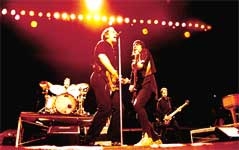Live From New York Page 4

The Ties that Bind Perhaps no other number on the DVD better illustrates Springsteen's back-to-basics approach than the tender "If I Should Fall Behind." Near the end of the song, the camera stays on a single, unmoving shot for two minutes as Springsteen strums and each member of the band in turn comes up to the mike to sing - a luxury they couldn't have afforded had they gone with flashier MTV-style cutting. "That was Bruce's idea," Zimny says, "to stay with that one shot and not cut away."
Another emotional highlight occurs at the end of the New York City Serenade featurette with the last song of the last concert, "Blood Brothers." Springsteen wrote this to express his feelings about the band, and it's apparent how deeply it affected everyone on stage. "Clarence is so caught up in the moment that he doesn't realize the band is moving forward, and you can see the tears in his eyes," Zimny says. "In a narrative approach, you stay true to moments like these - you don't cut away."
One thing that came up time and time again during these interviews was how deeply involved Springsteen has been with every detail of the CD, the HBO special, and the DVD. "He cares a great deal about having everything be exactly as he wants it to be," says Ludwig. "No one knows his fans better than he does, and he really wants to give them the best experience possible. Bruce spends a lot of time making these final decisions, like what songs are going to stay and which ones are going to go."
He even determined the transitions between the songs. "He had a sense of how long something should be playing and how to get into the next number," says Zimny. "In 'Land of Hope and Dreams,' we superimposed the faces of the band over the faces of the crowd, which was Bruce's idea, and I thought it worked great because it's a subtle way to convey unity."
Most artists don't bother to get involved with the mastering, but not Springsteen. Ludwig tells me that a typical mastering session takes about eight hours, but Bruce hunkered down with him for two days to finish the DVD. "He spent a lot of time working in a separate editing room," explains Ludwig. "He would go in there and listen to one of his raps, for instance, and decide to take out a phrase or put something back in. He would just keep going back and forth like that."
Of course, very few artists have the kind of control over their material that Springsteen does. "If you look at Bruce's records," notes Ludwig, "they don't say 'Copyright Sony Music.' They say 'Copyright Bruce Springsteen.'"










































